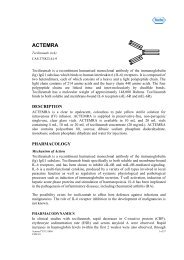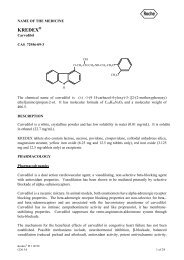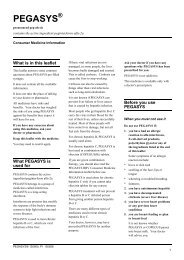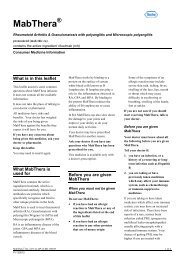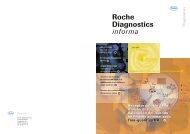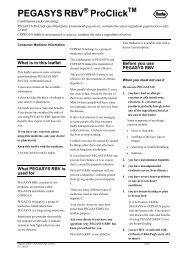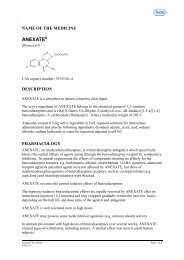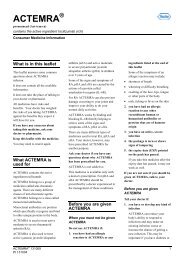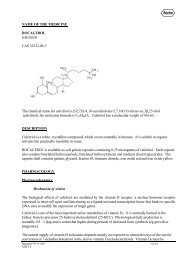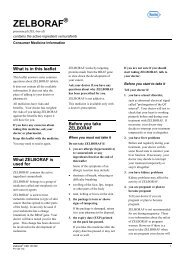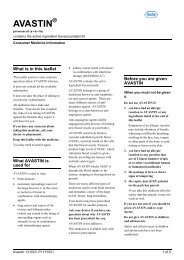Konakion MM Paediatric - Product Information (PI) - Roche Australia
Konakion MM Paediatric - Product Information (PI) - Roche Australia
Konakion MM Paediatric - Product Information (PI) - Roche Australia
You also want an ePaper? Increase the reach of your titles
YUMPU automatically turns print PDFs into web optimized ePapers that Google loves.
NAME OF THE MEDICINE<br />
KONAKION ® <strong>MM</strong> PAEDIATRIC<br />
Phytomenadione (vitamin K 1 )<br />
CAS-84-80-0<br />
O<br />
CH 3<br />
CH<br />
CH<br />
3<br />
3<br />
CH CH = C CH CH CH CH CH<br />
2 2 2 2 3<br />
O<br />
3<br />
DESCRIPTION<br />
<strong>Konakion</strong> ® <strong>MM</strong> <strong>Paediatric</strong> contains as the active ingredient phytomenadione (vitamin K 1 ) which is 2-<br />
methyl-3-phytyl-1,4-naphthaquinone. Phytomenadione is a clear, yellow, very viscous, odourless or nearly<br />
odourless oil with a molecular weight of 450.7. It is insoluble in water, soluble 1 in 70 in alcohol, more<br />
soluble in dehydrated alcohol; soluble in benzene, chloroform, ether and vegetable oils. It is stable in air but<br />
decomposes on exposure to light.<br />
The ampoule contains the active ingredient phytomenadione 2 mg/0.2 mL in a mixed micelles (<strong>MM</strong>)<br />
solution (the micelles are composed of glycocholic acid (bile acid) and lecithin in an aqueous solution).<br />
Other excipients used in manufacture are sodium hydroxide, hydrochloric acid and water for injection. The<br />
formulation is available in two volumes, phytomenadione 10 mg/1 mL (adult) and 2 mg/0.2 mL<br />
(paediatric).<br />
PHARMACOLOGY<br />
As a component of an enzyme system, vitamin K 1 promotes the formation in the liver of coagulation factors<br />
II (prothrombin), VII, IX and X and of the coagulation inhibitors protein C and protein S, within the body.<br />
Anticoagulants of the coumarin and indandione series cause a reversible displacement of vitamin K 1 from<br />
this enzyme system, thereby inhibiting the synthesis of these factors. Since this is a competitive<br />
displacement, <strong>Konakion</strong> is a specific antagonist for warfarin and similar anticoagulants. It is not capable,<br />
however, of terminating the action of heparin; for this purpose a salt of protamine should be used.<br />
Vitamin K 1 administration, which promotes synthesis of the abovementioned coagulation factors by the<br />
liver, can reverse an abnormal coagulation status or bleeding due to vitamin K 1 deficiency. Vitamin K 1 is<br />
ineffective in hereditary hypoprothrombinaemia or hypoprothrombinaemia induced by severe hepatic<br />
failure.<br />
Vitamin K 1 does not readily cross the placental barrier from mother to child and is poorly excreted in breast<br />
milk.<br />
Lack of vitamin K 1 leads to an increased tendency of vitamin K deficiency bleeding (VKDB).<br />
Administration of vitamin K 1 promotes synthesis of above-mentioned coagulation factors, can reverse an<br />
<strong>Konakion</strong> <strong>MM</strong> <strong>Paediatric</strong> ® <strong>PI</strong> 090703 1 of 5<br />
IS<strong>PI</strong> 2.0
abnormal coagulation status or bleeding due to vitamin K 1 deficiency and thereby reduces the risk of early,<br />
classic or late VKDB.<br />
Pharmacokinetics<br />
Absorption and Bioavailability<br />
Orally ingested phytomenadione is absorbed primarily in the middle portions of the small intestine.<br />
Optimum absorption is possible only in the presence of bile and pancreatic juice. The absolute<br />
bioavailability following intramuscular (IM) administration is approximately 80%. The onset of action<br />
occurs approximately 1-3 hours after intravenous (IV) administration and 4-6 hours after oral doses.<br />
Impaired gastrointestinal absorption may occur in conditions such as malabsorption syndromes, short bowel<br />
syndrome, biliary atresia and pancreatic insufficiency.<br />
Distribution<br />
The primary distribution compartment corresponds to the plasma volume. In blood plasma, 90% of vitamin<br />
K 1 is bound to lipo-proteins (VLDL portion). Vitamin K 1 plasma concentration is normally between 0.4<br />
and 1.2 ng/L. After IV administration of 10 mg <strong>Konakion</strong> <strong>MM</strong> to adults the plasma level after 1 hour is<br />
approximately 500 ng/mL and approximately 50 ng/mL at 12 hours. Vitamin K 1 is stored in the body for<br />
only short periods of time, does not readily cross the placenta and is poorly distributed into breast milk.<br />
Metabolism<br />
Vitamin K 1 is rapidly converted into more polar metabolites, including an active metabolite vitamin K 1 -2,3-<br />
epoxide. Some of this metabolite is reconverted into vitamin K 1 . Metabolism of vitamin K 1 after birth<br />
through epoxidation may occur more rapidly in premature infants.<br />
Elimination<br />
The elimination half-life in plasma is 1.5-3 hours. After metabolic degradation, vitamin K 1 is excreted in<br />
the bile and urine as the glucuronide and sulphate conjugates. Less than 10% of the medicine is excreted<br />
unchanged in the urine.<br />
INDICATIONS<br />
Prophylaxis and treatment of vitamin K deficiency bleeding (VKDB).<br />
CONTRAINDICATIONS<br />
<strong>Konakion</strong> <strong>MM</strong> <strong>Paediatric</strong> is contraindicated in patients with known hypersensitivity to any of the<br />
ingredients.<br />
PRECAUTIONS<br />
Anticoagulant Therapy<br />
<strong>Konakion</strong> <strong>MM</strong> <strong>Paediatric</strong> should be considered as adjunctive therapy to blood transfusions for severe<br />
haemorrhage due to anticoagulant therapy; it is not effective when heparin-like compounds have been used<br />
for anticoagulant therapy; minimal doses should be used to offset refractoriness to coumarin-like<br />
anticoagulants if long term anticoagulant therapy is intended.<br />
Effects on Fertility<br />
There have been no studies investigating the effect of phytomenadione on reproductive fertility.<br />
<strong>Konakion</strong> <strong>MM</strong> <strong>Paediatric</strong> ® <strong>PI</strong> 090703 2 of 5<br />
IS<strong>PI</strong> 2.0
Use in Pregnancy<br />
Not applicable, please refer to the <strong>Konakion</strong> <strong>MM</strong> 10 mg/1 mL <strong>Product</strong> <strong>Information</strong><br />
Use in Lactation<br />
Vitamin K 1 is poorly excreted into breast milk. <strong>Konakion</strong> is not recommended for nursing mothers as<br />
prophylaxis of haemorrhagic disease in the newborn.<br />
Use in Premature Infants<br />
Parenteral administration is associated with a possible risk of kernicterus in premature infants weighing less<br />
than 2.5 kg.<br />
Use in the Elderly<br />
Please refer to the <strong>Konakion</strong> <strong>MM</strong> 10 mg/1 mL <strong>Product</strong> <strong>Information</strong> for recommendations for this group.<br />
Carcinogenicity<br />
No studies on the potential carcinogenic activity of phytomenadione have been conducted.<br />
Mutagenesis<br />
Neither phytomenadione nor phytomenadione in the mixed micellar formulation showed evidence of<br />
mutagenic activity in Salmonella typhimurium. No evidence of chromosomal aberration in human<br />
lymphocytes was demonstrated in vitro for phytomenadione, but no tests of potential for DNA damage have<br />
been conducted.<br />
Interactions with Other Medicines<br />
Vitamin K 1 antagonises the effects of coumarin and indanedione-type anticoagulants (e.g. warfarin,<br />
phenindione).<br />
Co-administration of anticonvulsants can impair the action of vitamin K 1 .<br />
<strong>Konakion</strong> <strong>MM</strong> <strong>Paediatric</strong> should not be mixed with infusion solutions (see DOSAGE AND<br />
ADMINISTRATION).<br />
ADVERSE EFFECTS<br />
In rare cases anaphylactoid reactions have been reported after parenteral use of <strong>Konakion</strong> <strong>MM</strong> <strong>Paediatric</strong>.<br />
Should an anaphylactoid reaction occur, the usual measures must be taken (e.g. administration of adrenaline<br />
and supportive measures as required).<br />
Very rarely, injection site reaction, venous irritation or phlebitis has been reported in association with<br />
parenteral administration of <strong>Konakion</strong> <strong>MM</strong> solution to adults . This reaction is unlikely in neonates due to<br />
the small injection volume (0.2 mL). Rarely, injection site reactions may occur which may be severe,<br />
including inflammation, atrophy and necrosis.<br />
Facial flushing and sweating, and unusual taste have been reported.<br />
<strong>Konakion</strong> <strong>MM</strong> <strong>Paediatric</strong> ® <strong>PI</strong> 090703 3 of 5<br />
IS<strong>PI</strong> 2.0
DOSAGE AND ADMINISTRATION<br />
r<br />
<strong>Konakion</strong> <strong>MM</strong> <strong>Paediatric</strong> may be given by intramuscular, oral or intravenous routes. Care should be taken<br />
to ensure the correct dose is given for the chosen route of administration.<br />
Prophylaxis<br />
All healthy neonates<br />
1 mg (0.1 mL) IM at birth is recommended.<br />
Alternatively, 2 mg (0.2 mL) orally at birth, at the time of newborn screening (3-5 days of age) and at 4<br />
weeks.<br />
For predominately formula fed neonates the last oral dose may be omitted.<br />
Neonates with special risk factors<br />
1 mg IM at birth is recommended in neonates with special risk factors. If the neonate has special risk<br />
factors and weighs less than 1.5 kg, then 0.5 mg (0.05 mL) is recommended (see PRECAUTIONS).<br />
The size and frequency of further doses should be based on clinical grounds and coagulation status.<br />
Clotting and <strong>PI</strong>VKA-II (Proteins Induced in Vitamin K Absence) tests are not to be relied upon as<br />
indications of deficiency as the relationship between biochemical evidence of deficiency and late VKDB is<br />
not clear.<br />
Special Risk Factors<br />
Early and/or classical VKDB<br />
Risk factors include: prematurity, birth asphyxia, delay in establishment of oral feeding, maternal use of<br />
anticoagulants, antiepileptics or tuberculostatics and antibiotic treatment.<br />
Late VKDB<br />
Risk factors include liver dysfunction including obstructive jaundice, malabsorption and prolonged use of<br />
antibiotics.<br />
Therapy<br />
Initially, 1 mg by intravenous injection, with further doses as required, based on the clinical grounds and<br />
coagulation status. In certain circumstances, treatment with <strong>Konakion</strong> <strong>MM</strong> <strong>Paediatric</strong> may need to be<br />
accompanied by more direct forms of effective haemorrhage control, such as transfusion of whole blood or<br />
coagulation factors, to compensate for severe blood loss and the delayed response to vitamin K 1 .<br />
VKDB should be suspected with any minor bleed in infants less than 6 months of age, even if coagulation<br />
tests are within normal limits. Clotting and <strong>PI</strong>VKA-II tests are not to be relied upon as indications of<br />
deficiency as the relationship between biochemical evidence of deficiency and late VKDB is not clear.<br />
Administration<br />
Parenteral use<br />
<strong>Konakion</strong> <strong>MM</strong> <strong>Paediatric</strong> should not be diluted or mixed with other parenteral medications.<br />
Oral use<br />
(with the dispenser included in the package)<br />
- after breaking the ampoule, place the dispenser vertically into the ampoule;<br />
- withdraw the solution from the ampoule into the dispenser until the solution reaches the marking on the<br />
dispenser ( = 2 mg vitamin K 1 );<br />
<strong>Konakion</strong> <strong>MM</strong> <strong>Paediatric</strong> ® <strong>PI</strong> 090703 4 of 5<br />
IS<strong>PI</strong> 2.0
- administer the contents of the dispenser directly into the infant’s mouth.<br />
- repeated doses are advised if the infant spits out or vomits an oral dose or alternatively diarrhoea occurs<br />
within 24 hours of administration.<br />
OVERDOSAGE<br />
There is no known clinical syndrome attributable to hypervitaminosis of vitamin K 1 .<br />
The following adverse events have been reported concerning overdose with use of KONAKION in neonates<br />
and infants: jaundice, hyperbilirubinaemia, increased glutamine-oxaloacetic transferase and gammaglutamyl<br />
transferase, abdominal pain, constipation, soft stools, malaise, agitation and cutaneous eruption.<br />
The causality of those cannot be established. The majority of these adverse events were considered nonserious<br />
and resolved without any treatment.<br />
Treatment of suspected overdose should be aimed at alleviating symptoms and consist of general supportive<br />
measures.<br />
Contact the Poisons <strong>Information</strong> Centre for advice on management of overdosage.<br />
PRESENTATION AND STORAGE CONDITIONS<br />
<strong>Konakion</strong> <strong>MM</strong> <strong>Paediatric</strong> ampoules 2 mg/0.2 mL (filling volume 0.3 mL): pack of five amber glass<br />
ampoules and 5 dispensers (graduated oral plastic syringes).<br />
Store below 25ºC. Protect from light.<br />
At the time of use, the <strong>MM</strong> ampoule solution should be clear. Following incorrect storage, the solution may<br />
become turbid or phase-separation may occur. In this case the ampoule must not be used.<br />
During the shelf-life of KONAKION it is known that impurities will develop. Although there has been no<br />
definite evidence of a safety problem due to these impurities, there are also no adequate safety and toxicity<br />
data in relation to the impurities. In order to minimise the amount of impurities, prescribers are encouraged<br />
to use the product early in the shelf-life wherever possible.<br />
POISON SCHEDULE OF THE MEDICINE<br />
Unscheduled<br />
NAME AND ADDRESS OF THE SPONSOR<br />
ROCHE PRODUCTS PTY LIMITED<br />
ABN 70 000 132 865<br />
4-10 INMAN ROAD<br />
DEE WHY NSW 2099<br />
TGA Approval Date: 3 July 2009<br />
<strong>Konakion</strong> <strong>MM</strong> <strong>Paediatric</strong> ® <strong>PI</strong> 090703 5 of 5<br />
IS<strong>PI</strong> 2.0



